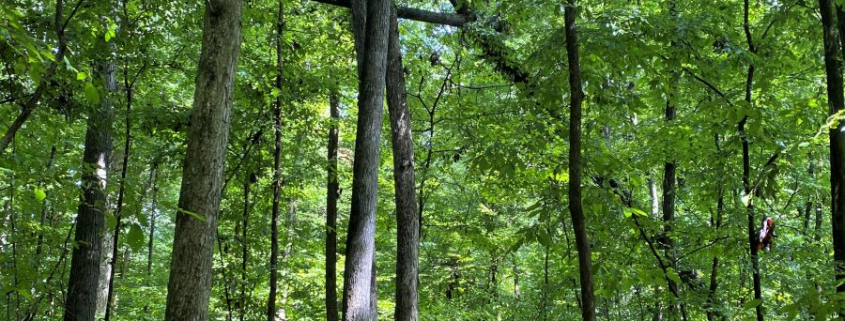Late Summer Rambling in a Soggy Bottomland Forest
One and two-thirds inches of rain had fallen over the 36 hours ending late morning August 19, 1921, late summer conditions perfect for mushroom growth and development in the hardwood bottomlands along the Tennessee River in Limestone County Alabama, just fifteen miles from my home in Madison. I entered a forest still dripping as clouds thinned, slogging in nearly knee-high rubber boots, eyes peeled for fungal kingdom spore production organs…mushrooms! The mosquitoes and I love these maturing riparian hardwood forests. Well, they like living there, lying in wait for a blood-rich fur-free biped to wander past.
In the Kingdom of Fungi (Flora, Fauna, and Funga)
I’ve observed previously in my Posts that when I earned my forestry degree (1973), fungi sat within the plant kingdom, among the non-flowering plants. Shortly thereafter, fungi ascended to their own distinct kingdom, an epic promotion! Contrast that shift to the 2006 fall of Pluto from planet to simply a dwarf planet. The once proud planet fell from grace: Pride goeth before the fall.
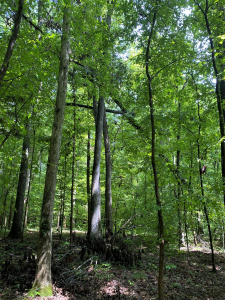
My purpose with this Post is to show the rich diversity of fungi and associated life I encountered and photographed on a soggy mid-August late afternoon in a bottomland hardwood stand. Here is violet-toothed polypore heavily colonizing a downed red oak, depicting the ongoing cycle of life and death.
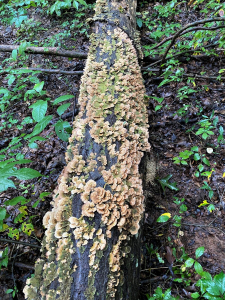
Closer inspection evidenced the dense mycelia growth, hidden from view, that surely resides within the dead wood. The close-up below right corroborates the violet-toothed moniker.
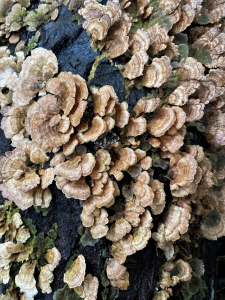
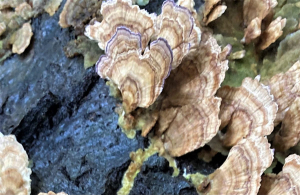
The Grand Circle of Life and Death
I have often mentioned and presented photo-evidence of Nature’s grand circle of life and death. John Muir, ever the uber-observer and elegant synthesizer of Nature’s ways offered this relevant conclusion:
One is constantly reminded of the infinite lavishness and fertility of Nature — inexhaustible abundance amid what seems enormous waste. And yet when we look into any of her operations that lie within reach of our minds, we learn that no particle of her material is wasted or worn out. It is eternally flowing from use to use, beauty to yet higher beauty; and we soon cease to lament waste and death, and rather rejoice and exult in the imperishable, unspendable wealth of the universe, and faithfully watch and wait the reappearance of everything that melts and fades and dies about us, feeling sure that its next appearance will be better and more beautiful than the last.
Within this mature bottomland hardwood forest at Wheeler National Wildlife Refuge a main canopy occupant (I am uncertain whether it is an oak or hickory) stands 3-5 years dead (my estimate based upon bark shedding and all but the largest crown branches already fallen). Nearby trees are sending leafy stems into the still evident canopy opening…and will close the void within another summer or two.
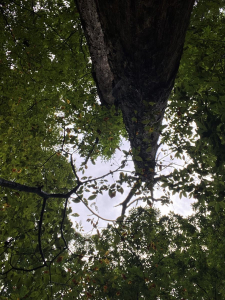
Much of the bark has sloughed from the trunk and lies as thick mulch at its base. Wood-boring beetles and decay fungi are weakening the stem so that near term, a fresh breeze will reintroduce its biomass to the ground and, in time, incorporate it into the soil. A fleshy polypore mushroom is disseminating countless spores to spread the fungal species via wind to other dead and dying woody biomass.
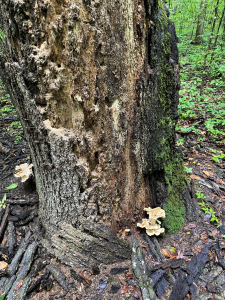
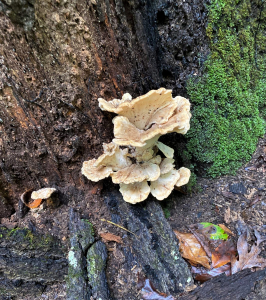
This black staining polypore produced considerable weight in its fruiting bodies (mushrooms). From mushroomknowhow.com:
Black staining polypore mushrooms are parasitic and saprobic in their nature. This means that they parasitize or feed on dead or decaying tree matter. They can grow either on the ground (on or around the roots of trees) and on the stumps or logs of dead or decaying deciduous trees such as oaks, beeches and maples. The species is found exclusively in North America, although close relatives of these polypores known as Meripulus giganteus can be found in Northern Europe as well. Their peak season is late July to November.
When handled, especially the undersides, the surface bruises with dark splotches where touched.
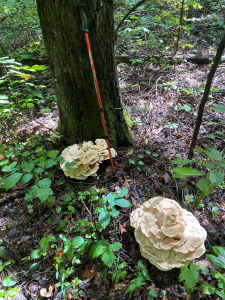
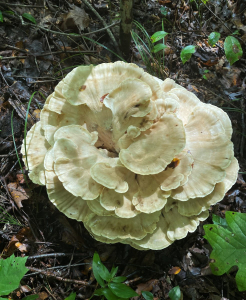
The species is described as edible. I’ve found that only the outer 1.5-2 inches of the fans are palatable (the remainder too tough and fibrous). Their fragrance is strong and earthy. I clean and finely chop the harvested edges, boil with seasonings to create a stock for a thick rice soup. Delicious, but only if you are 100 percent certain of identity. Please don’t rely upon my photos to base your species identification.
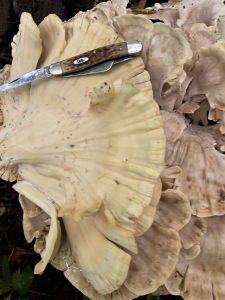
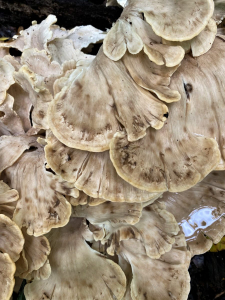
I stumbled upon two fresh clusters of chicken of the woods, considered by many as culinary delights. From ediblewildfood.com:
Chicken of the woods is parasitic and saprobic on living and dead oaks (also sometimes on the wood of other hardwoods). It causes a reddish brown cubical heart rot, with thin areas of white mycelium visible in the cracks of the wood. It is considered an annual favourite. These mushrooms do not appear until well after the fungus has attacked the tree. Originally described in 1789 by French botanist and mycologist Jean Baptiste Francois (Pierre) Bulliard, this spectacular polypore was given its current name in 1920 by the famous American mycologist William Alphonso Murrill (1869 – 1967). This fungi typically grows in large clusters in the summer and fall.
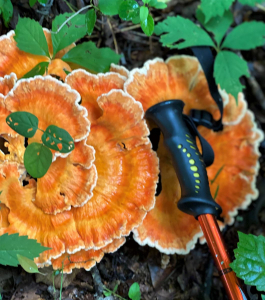
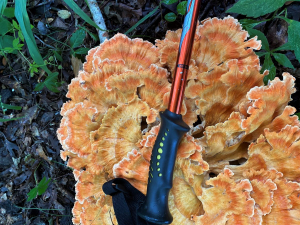
Such a thrill to find those orange to peach beauties. I harvested perhaps half of each cluster, cleaned, sliced into 8-10 square-inch filets, battered, and fried like chicken. Delectable! Again, be absolutely certain before consuming any wild-foraged mushroom.
I switch gears now to some attractive and interesting non-edibles. First, here is Stereum versicolor, a woody, fan-shaped mushroom that is strictly saprobic, consuming dead woody tissue.
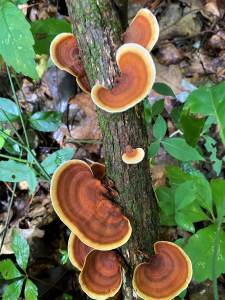
This is a white jelly fungus, a gelatinous decay fungus. I’ve read that some of the jellies are edible. I have not ventured into that zone of certainty.
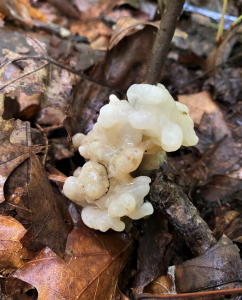
This mushroom’s name, indigo milk cap, is descriptive, enhanced by its background of green moss.
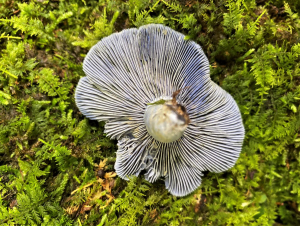
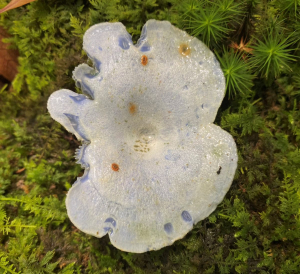
I’m not sure what to say about this dog’s nose fungus (Peridoxylon petersii). I found little about it online, other than several sites showing an image alongside a closeup of a dog’s nose. The look and even the cold wet feel do indeed resemble a canine proboscis! Shall I throw this find into the forest fungus oddity category?
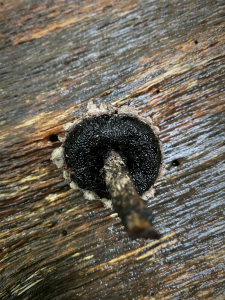
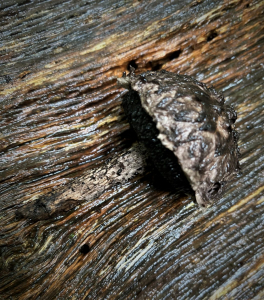
Another fungi curiosity is devil’s dipstick (also known as demon fingers, dog stinkhorn, elegant stinkhorn, and headless stinkhorn). From NC State Cooperative Extension online:
Elegant stinkhorn (Mutinus elegans) is a foul smelling fungus found anywhere woody material is rotting – old stumps and branches, mulch, lawns. The ‘horn’ is the visible fruiting body of the network of mycelia that has been growing through the woody material, breaking it down and releasing nutrients to other plants. At some point, this network ‘decides’ it is time to reproduce and creates a white egg like structure that is partially above ground. It is from this structure that the pink to orange columnar fruiting body develops. This development can take only a few hours. The top of the structure is covered in a slimy, greenish brown mass of spores that smells of rotting meat or worse. The smell attracts insects which become covered in the slimy spores and deposit them away from the ‘parent’ mycelia. This is a very unusual occurrence within the fungus world. Most rely on wind to disperse their minute spores.
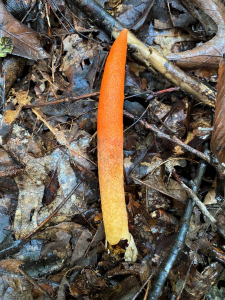
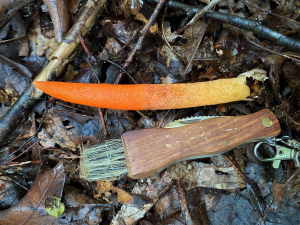
Let’s shift from foul and repugnant to tasty! This delightful mushroom is a red chanterelle. I harvest, clean, slice into strips and sauté with butter, add a little salt and pepper, and either eat fresh with meat, rice, eggs, pizza, and sundry other dishes, or freeze for future use.
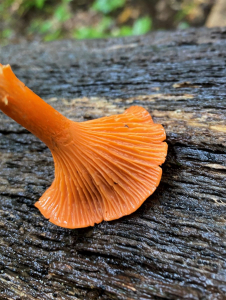
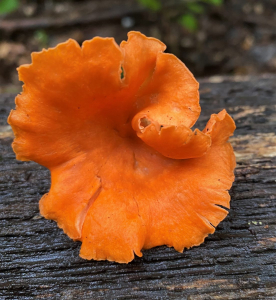
This flame chanterelle is another species of the same genus (Cantharellus). The bulk of my 30-35 pounds of frozen Cantharellus are smooth chanterelles, whose peak season extended from late June through late July. Yes, that’s a poison ivy leaf in the below left image. Unfortunately, poison ivy is a common ground cover, standing up to two feet, in the bottomland hardwood stands where I’ve found the greatest yields of chanterelles. I try to avoid direct contact with my hands as I harvest. Wearing calf-high rubber boots protects my lower legs. However, upon returning home, I immediately toss my outer clothes into the washing machine and head for the shower before cleaning and processing the harvest. All of that is a small price to pay for my woodland adventures and foraging bounty.
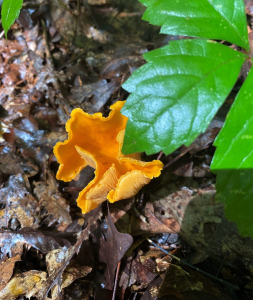
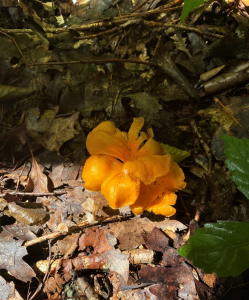
Burls, Mosses, Flowers, and Butterflies
Although I’ve concentrated most of this Post on the fungi kingdom, I must include some other observations. This three foot diameter willow oak sported a huge basal burl, a growth abnormality likely resulting from physical injury or fungal infection stimulating unregulated wood cell production. A human comparison is a benign tumor. Large burls such as this one are prized by wood workers who cherish their spectacular grain patterns.
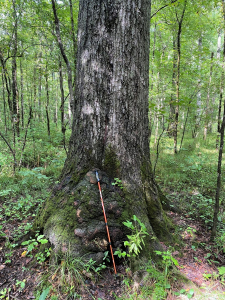
I could not resist photographing this moss-adorned and lichen-splotched sapling backdropped by a three-foot diameter oak.
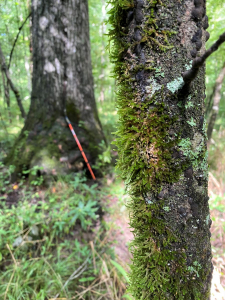
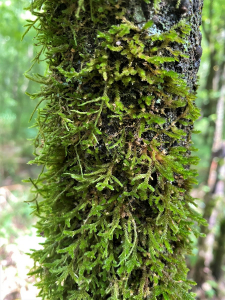
Snow squarestem in full flower lined a gravel access road entering the forest. An eastern tiger swallowtail visited the squarestem, allowing me to snap a quick photo. Summer in our riparian forests offers all manner of bounty…abundant soul-sustenance, as well as victual delights for the palate.
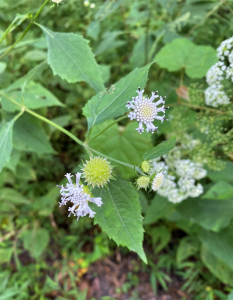
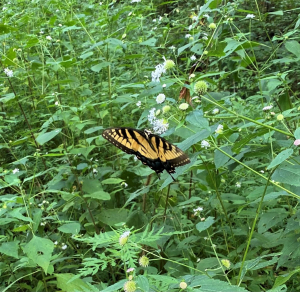
Long ago I read Euell Gibbon’s Stalking the Wild Asparagus (1962), a best-seller, presenting a species-by-species accounting of his foraging for wild edibles. I was eleven years old, a budding outdoor enthusiast who devoured the book’s content, imagining that I might learn to live off the land. Gibbon’s once said:
My love affair with nature is so deep that I am not satisfied with being a mere onlooker, or nature tourist. I crave a more real and meaningful relationship. The spicy teas and tasty delicacies I prepare from wild ingredients are the bread and wine in which I have communion and fellowship with nature, and with the Author of that nature.
Clearly, my communion and fellowship with Nature depend on far more than the few species of edible wild mushrooms that I recognize, harvest, and consume. My relationship with Nature extends from body to heart, soul, mind, and spirit…a communion far stronger and rewarding to my own Life and Living. A summer woodland hike through a southern bottomland hardwood forest yields delight and satisfaction beyond measure.
Thoughts and Reflections
I offer these observations:
- Winston Churchill once said, “There is something about the outside of a horse that is good for the inside of a man.” I say the same of communing with Nature.
- Like Euell Gibbons, “My love affair with nature is so deep that I am not satisfied with being a mere onlooker.”
- Wherever I roam, Nature inspires and rewards my heart, mind, body, soul, and spirit.
Inhale and absorb Nature’s elixir. May Nature Inspire, Inform, and Reward you!
Note: All blog post images created & photographed by Stephen B. Jones unless otherwise noted. Please circulate images with photo credit: “©2021 Steve Jones, Great Blue Heron LLC. All Rights Reserved.”
Another Note: If you came to this post via a Facebook posting or by an another route, please sign up now (no cost… no obligation) to receive my Blog Post email alerts: http://eepurl.com/cKLJdL
And a Third: I am available for Nature-Inspired Speaking, Writing, and Consulting — contact me at steve.jones.0524@gmail.com
Reminder of my Personal and Professional Purpose, Passion, and Cause
If only more of us viewed our precious environment through the filters I employ. If only my mission and vision could be multiplied untold orders of magnitude:
Mission: Employ writing and speaking to educate, inspire, and enable readers and listeners to understand, appreciate, and enjoy Nature… and accept and practice Earth Stewardship.
Vision:
- People of all ages will pay greater attention to and engage more regularly with Nature… and will accept and practice informed and responsible Earth Stewardship.
- They will see their relationship to our natural world with new eyes… and will understand more clearly their Earth home.
Tagline/Motto: Steve (Great Blue Heron) encourages and seeks a better tomorrow through Nature-Inspired Living!
Steve’s Three Books
I wrote my books Nature Based Leadership (2016), Nature-Inspired Learning and Leading (2017), and Weaned Seals and Snowy Summits: Stories of Passion for Place and Everyday Nature (2019; co-authored with Dr. Jennifer Wilhoit) to encourage all citizens to recognize and appreciate that every lesson for living, learning, serving, and leading is either written indelibly in or is powerfully inspired by Nature.
I began writing books and Posts for several reasons:
- I love hiking and exploring in Nature
- I see images I want to (and do) capture with my trusty iPhone camera
- I enjoy explaining those images — an educator at heart
- I don’t play golf!
- I actually do love writing — it’s the hobby I never needed when my career consumed me
- Judy suggested my writing is in large measure my legacy to our two kids, our five grand kids, and all the unborn generations beyond
- And finally, perhaps my books and Blogs could reach beyond family and touch a few other lives… sow some seeds for the future


All three of my books (Nature Based Leadership; Nature-Inspired Learning and Leading; Weaned Seals and Snowy Summits) present compilations of personal experiences expressing my (and co-author Dr. Wilhoit for Weaned Seals and Snowy Summits) deep passion for Nature. All three books offer observations and reflections on my relationship to the natural world… and the broader implications for society. Order any and all from your local indie bookstore, or find them on IndieBound or other online sources such as Amazon and LifeRich.

